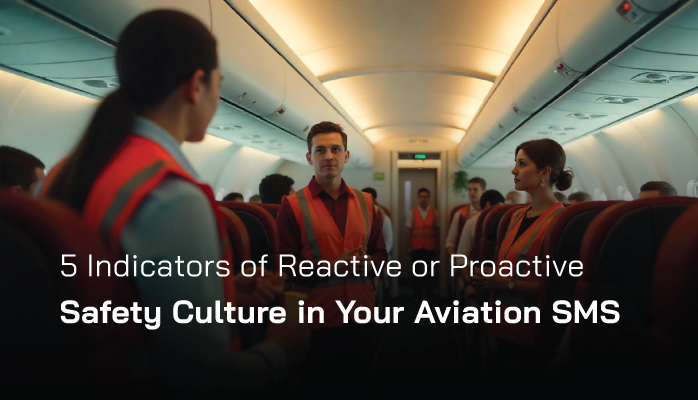Not So Obvious

The line between reactive and proactive safety workplaces is unfortunately not as concrete as anyone would like. If it were so obvious, many organizations would be far less reactive. The fact is that most cultures are less proactive than they would like to be.
Granted, there are some obvious indicators that an organization is only responding to accidents rather than actively trying to prevent them. For example, we generally understand reactive safety workplaces as only “putting out fires” as they come up. But accepting that reactive workplaces are only this is a rather superficial assessment.
There are more subtle flairs to how reactive cultures function.
I consider "putting out fires" as a symptom of other behaviors that are more exemplary of “firefighting” risk management cultures.
Related Aviation SMS Risk Management Articles
- Difference Between Reactive, Predictive and Proactive Risk Management in Aviation SMS
- How to Practice Reactive, Proactive, and Predictive Risk Management in Aviation SMS
- 3 Things You Are Doing to Hurt Proactive Risk Management in Aviation SMS
When an aviation safety program is brand new, the safety culture is necessarily reactive because, as every workplace has a different set of safety hazards, that organization is discovering what unique hazards they face.
With -
- A budget
- Upper management cooperation:
- Hazard identification training;
- And a good understanding of what a proactive safety culture looks like
- the SMS will mature.
Definitions: Proactive vs. Reactive Risk Management
Let’s make two definitions: the more obvious and generally accepted one; and one that jumps in a little deeper.
Reactive risk management is firefighting and dealing with issues as they come up. We can also understand reactive cultures as ones that lack the structural integrity and practices establishing pattern-based safety policies and procedures.
The difference between the two definitions is the difference between understanding the action (firefighting) and the reason behind the action (lack of structure).
Proactive risk management is generally understood as dealing with issues before they come up. More specifically, proactive risk management tends to use historical patterns to make policy/procedure decisions based on anticipation.
Such patterns don’t have to be “trends,” just simply the logic that: if A then B. For example:
- If weekly safety meeting, then 40% reduction in critical issues
- If no employee overtime, 15% reduction in reported issues
And so on. So in a way, the primary difference is that proactive safety cultures use reported issues to their advantage.
Here’s a quick look at 6 creative indicators of proactive safety.
1 – A Stranger Could Be Familiar With an SMS Program in a Week

I realize this is kind of a strange one, but I promise it makes a lot of sense. An old mentor always used to stress being so organized that a stranger could navigate my workspace without ever having to "search." In the same way, if a stranger, such as a new manager, employee, or auditor, can easily become comfortable with an SMS, it implies:
- Effective practices and procedures
- Comprehensive and well-written policies
- The well-organized sense of duties and responsibilities to the SMS
- Efficient, trackable flow of safety information
All of these points boil down to the fact that the SMS has a strong structural backbone – which is the foundation of any anticipatory proactive risk management program.
Related Proactive Risk Management in Aviation SMS
- How to Practice Proactive Risk Management in Aviation Safety
- 7 Great Incentives for Proactive Risk Management
- 20 Questions for Your Safety Risk Management Process in Aviation SMS [With Free Checklists]
2 – Safety Issues Usually Fall Under Existing Procedures
Safety issues will always come up. There’s no escaping that basic fact. We are human and no number of policies and procedures will “cure” humans of their humanness.
But a fairly simple – and quantifiable – measure of how proactive an SMS is can be seen in how many reported safety issues fall under procedures/policies that are accounted for.
The ratio of reported issues accounted for/not accounted for in policy is a fantastic measure of proactivity. In other words, how often are safety issues reported that have not been anticipated by a procedure or policy?
3 – You Have Regular Policy/Procedure Reviews Scheduled
This one is kind of a no-brainer, and I think most aviation SMS does a pretty good job at this. Making sure policies and procedures keep up with changing technologies, employee dynamics, and environments is equally important to creating new policies to account for them.
Having regular – as in very often – reviews of policy statements is critical to the growth of an SMS program. Growth cannot happen without it.
A primary indicator that reviews and updates are not frequent enough is that already accounted for issues will start to be reported with greater frequency. Ideally, reported issues will be spread across a wide categorical range.
4 – Regular Safety Promotion Training in Small Doses
When safety risk management programs function exceptionally well, they tend to sneak in safety promotion training and reminders on a very regular – i.e. daily – basis. Safety training programs don’t have to be a formal ordeal.
In fact, safety training is best served in small bites. It can be as simple as a-
- daily reminder,
- funny cartoon,
- or anecdotal story
-that reminds employees of a particular best practice or safety issue. Training and safety promotion activities should go hand in hand and be consistently visible.
Related Aviation Safety Promotion Articles
- 4 Pillars | What Is Safety Promotion Component (the "Overlooked" Pillar)
- Effective Safety Promotion, the Informal Way for Aviation SMS
- 10 Best Ways to Promote Safety in Your Aviation SMS [With Free Checklist]
5 – Have Custom Trending Charts Specific to Your Organization
In many ways, safety risk management is a highly numerical practice. And I cannot applaud risk management's trending charts enough. They are a wonderful proactive hazard analysis tool. Based on historical safety data, trending charts allow safety managers to compare any number of safety factors to establish relationships and complex patterns.
For excellent proactive safety cultures, basic trending charts are deficient. Proactive SMS will have numerous trending charts that are customized to the particular proclivities and tendencies of their environment.
6 – Regularly Create New Trending Charts
Employee turnover. Changing technology and external (i.e. FAA, Transport Canada) policies. Climate change. These are just a few of the things that bear down on the ongoing and ever-changing safety needs of an organization.
Proactive risk management cultures regularly create new custom trending charts, both to update charts that lose relevancy, as well as to look for more complex and insightful ways of assessing the trend and likelihood of possible risks.
Related Articles on Trending Charts in Aviation SMS
- Aviation Safety Managers' Best Friend - Trending Charts
- How to Prepare Data for Trend Analysis in Risk Management Programs
- Six Steps How to Perform Trend Analysis in Aviation SMS
Final Thought
Something I appreciate about the above list of proactive safety culture indicators is how quantifiable and trackable it is.
- How often does your SMS purposefully practice safety promotional training?
- How often does your SMS create new trending charts, and how many custom charts does it use now?
- How often are safety issues submitted whose cause was confusion about policies and procedures?
So while these tools are used as an assessment of aviation safety risk management proactivity, you can also easily assess your assessment tools.
Last updated September 2025.








